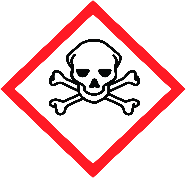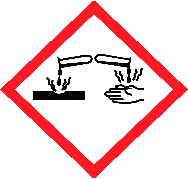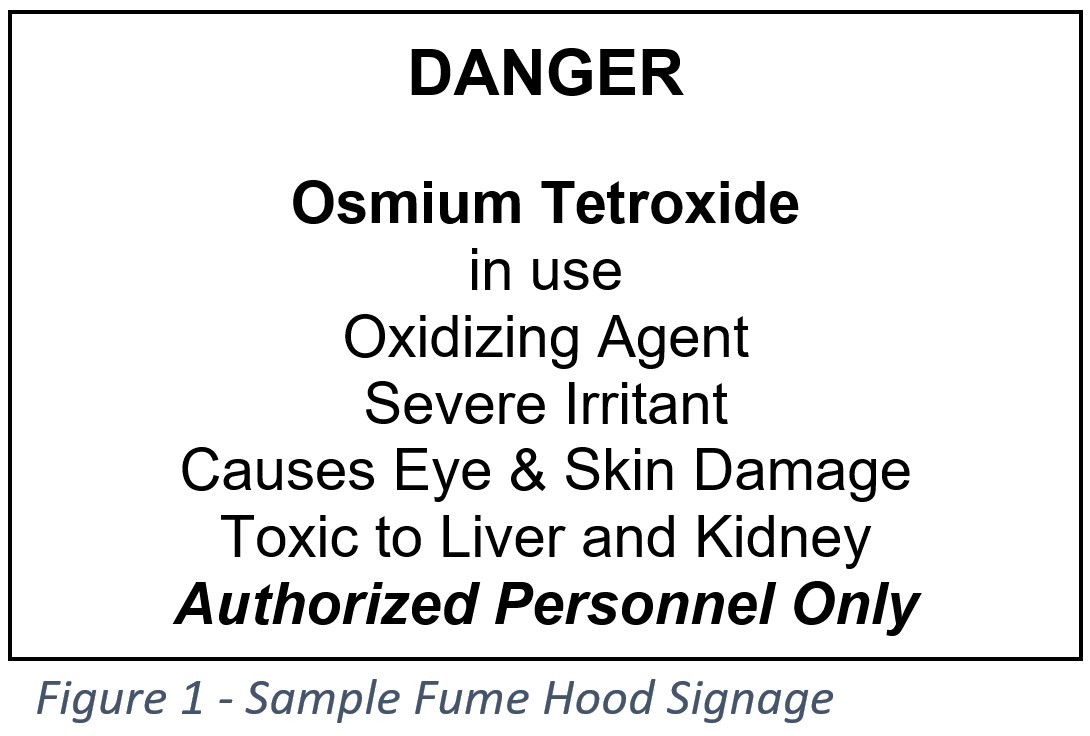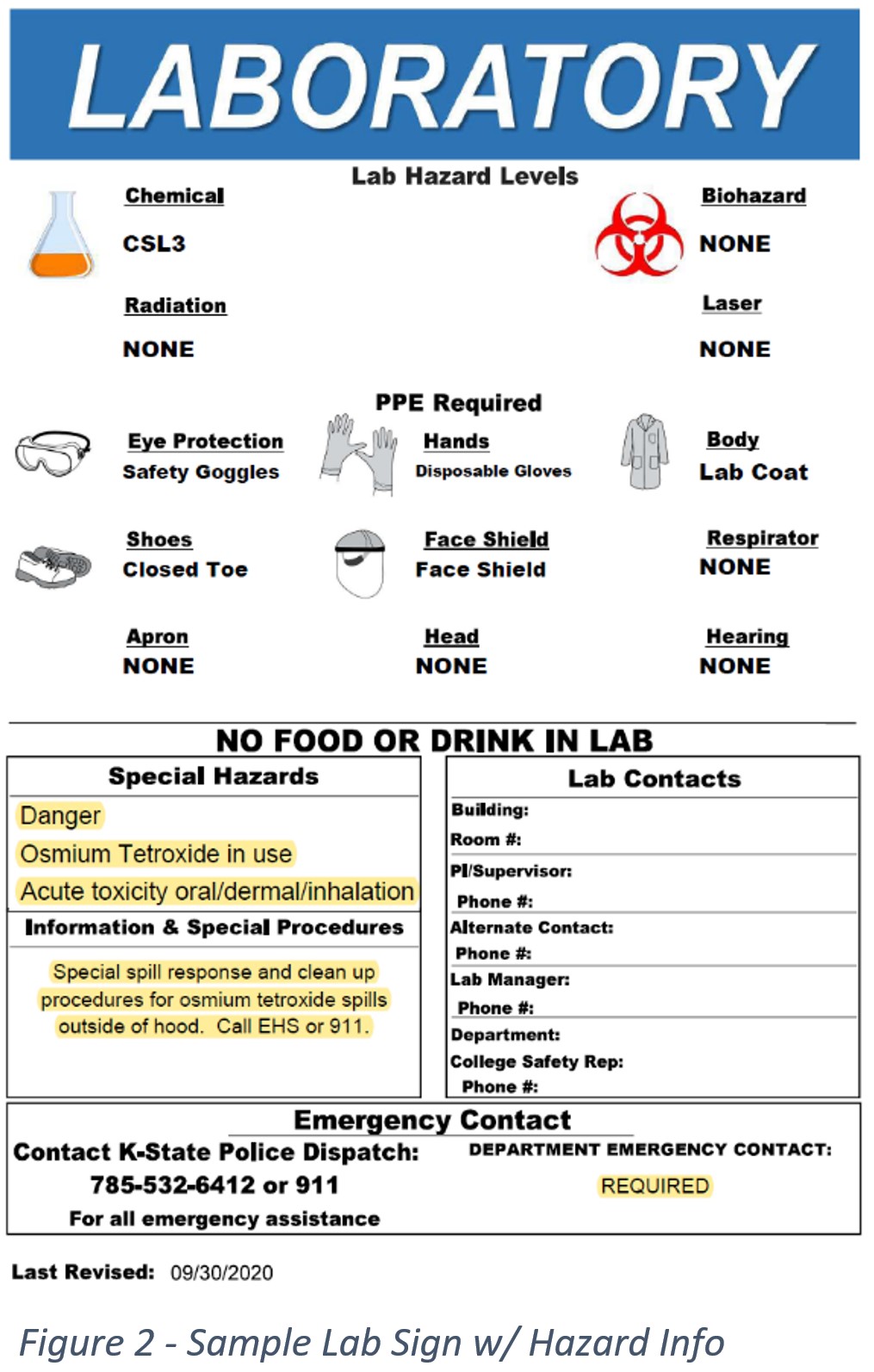Osmium Tetroxide (CAS 20816-12-0) Guidance & Procedures
OsO4 or O4Os
Syn: Osmic acid, perosmic oxide, osmium (VIII) oxide
Description: Colorless to pale yellow crystalline solid or mass with pungent (unpleasant), acrid, chlorine-like odor.
MW: 254.2 g/mol
Liquid above 105° F

Health and Safety Information
High acute toxicity; severe irritant of the eyes and respiratory tract; vapor can cause serious eye damage. Routes of exposure include skin & eye contact, inhalation or ingestion (if swallowed). May cause organ damage (CNS, eyes, skin, kidney). Suspect reproductive hazard. The level of health risk depends upon the dose, duration, and work being conducted.


Permissible limits
OSHA permissible exposure limit (PEL): 0.002 mg/m3 TWA
NIOSH recommended exposure level (REL): 0.002 mg/m3 (0.0002 ppm) TWA and
0.006 mg/m3 (0.0006 ppm) short term exposure level (STEL)
IDLH: 1 mg Os/m3 (Based on acute inhalation toxicity data in humans. 1 mg/m3 is suggested tolerable for 30 minutes for escape purposes)
Symptoms of Exposure
Irritation eyes, respiratory system; lacrimation (discharge of tears), visual disturbance; conjunctivitis; headache; cough, dyspnea (breathing difficulty); dermatitis
Toxicity Data
Table 1- Lethal Concentration Data
|
Species |
Reference |
LC50 |
LCLo |
Time |
Adjusted 0.5-hr LC (CF) |
Derived value |
|
Rabbit |
Brunot 1933 |
----- |
1,316 mg/m3 |
30 min |
987 mg Os/m3 (1.0) |
99 mg Os/m3 |
|
Rat |
Shell 1961 |
----- |
423 mg/m3 |
4 hr |
317 mg Os/m3 (2.0) |
32 mg Os/m3 |
|
Mouse |
Shell 1961 |
----- |
423 mg/m3 |
4 hr |
317 mg Os/m3 (2.0) |
32 mg Os/m3 |
Source: CDC https://www.cdc.gov/niosh/idlh/20816120.html
Physical Hazards
Corrosive (review SDS)
LEL: Noncombustible as solid
Solid is volatile. Note: Begins to sublime below melting point & BP (boiling point: 265.5°F (129.7°C)
Readily vaporizes from aqueous solution even at room temperature
Emits toxic fumes when heated to decomposition.
Consult the appropriate SDS for the formulation ordered and/or working solution(s) used for specific health and safety information and physical properties.
Engineering Controls
Work with osmium tetroxide must be performed inside of a certified chemical hood (fumehood). Contact KSU Environmental Health and Safety (EHS) to perform review of hood function prior to start of initial work. If work outside the hood is unavoidable, the work procedures must be reviewed and approved by in advance and will require use of respiratory protection.
- Work in lab with 100% exhaust (single pass)
- Perform work in chemical “fume” hood (pass/inspected within last 13 months). Work within hoods equipped with functioning flow indicator gauge (regardless ensure hood remains operational by checking for inward flow before daily use). The hood must be equipped with a functioning audible flow alarm. Do not disengage or alter the flow alarm. If it is not functioning or if it must be temporarily altered to routinely set up equipment, contact EHS to coordinate alterations.
- Use in hood when preparing and handling solutions
- Lower sash to operating height
- Keep work surface in hood clear of unnecessary materials and equipment.
- Ensure inlets of hood are not obstructed by glassware, equipment, etc.
- Work six inches inside the hood. Do not block air foil.
- Post warning sign on the fume hood indicating restricted use and list use of osmium tetroxide
- Protect all work surfaces with plastic backed absorbent pads to containment spills. Ensure pads or debris don’t block hood baffles (airflow in back of hood). Dispose of contaminated or potentially contaminated pads in bags and label and manage as hazardous waste.
- All lab ware that has contacted osmium tetroxide must be decontaminated by rinsing or dipping in corn oil or aqueous solutions of sodium sulfide or sodium sulfite before removing from the hood.
- Clean spills immediately. See spill response section for additional information.
- Keep containers closed when not in use.
- Conduct hood clean up at the end of research/project activity using the approved clean-up methods. Decontaminate/clean hood thoroughly prior to submitting work orders for hood repair.
- Ensure that the safety shower and eyewash are operational and access is unblocked.
Administrative Controls
- Provide a hard copy of the current SDS in readily accessible and visible area of the work space
- PI is responsible to train all personnel working with material, including:
- safety controls
- provide copy of this SOP and lab-specific SOP for osmium tetroxide
- review the SDS and provide a current copy
- review health hazards and symptoms of exposure
- review emergency response procedures
- ensure lab staff have completed Hazard Communication and Hazardous Waste Awareness training.
- Recommended additional trainings: Lab Safety online training and Fume Hood training [Note: Laboratory Safety Training is required for all new lab personnel]
- List osmium tetroxide under special hazards on the KSU Lab Sign and resubmit (email) lab sign to EHS with current lab and emergency contacts. See figure 2 for an example. Use the term “Danger” in the special hazards section of the sign. Depending on volumes and concentrations in routine use, the lab sign header “Warning” or “Danger” may be indicated (in place of Laboratory).
- No food or drinks in lab.
- Purchase as a liquid to avoid particulate exposure of powdered form.
- Must have eye wash (inspected/run weekly) within the lab where work performed and access to vicinity emergency shower. Keep access to emergency eye wash and shower unobstructed.
- All work areas where materials is handled or stored must have plastic backed absorbent pads and/or secondary containment. Replace pads after any spill, potential spill, soiling or damage (ideally daily). Pads are recommended for lining secondary containers.
- When moving pure osmium tetroxide (e.g., to a chemical hood or other lab), do not remove it from the secondary containment during transport.
- Dispense and/or prepare the smallest amount necessary for the procedure. If a balance must be used, weighing should take place inside the labeled hood.
- Report any signs or symptoms of exposure to EHS. Exposure monitoring (sampling) and medical surveillance may be required if employees present with symptoms of exposure or if vapors or dust approach reported action levels (where applicable).
- Dispose of any materials that show signs of oxidation (turn black). Place in double plastic bags and request disposal.
- Avoid contact with incompatible materials.
- Poisonous chlorine gas formation possible with contact to hydrochloric acid.
- Easily oxidizes organic materials
- Store in dry place in closed containers. Place these in secondary containment (sized to contain leakage). See Storage information.
- Wash hands upon removing gloves and before exiting the lab.
Personal Protective Equipment
Wear personal protective equipment (PPE) aimed at preventing any skin and eye contact regardless of state or concentration used. Cover any exposed skin where contact is possible.
- Lab coat (chemically resistant recommended), buttoned and sleeves rolled down, chemically-resistant wrist guards or gauntlet gloves, full length pants/skirt.
- Safety goggles (not glasses) – snug to face, face shield (with goggles) if mixing large volumes or working with pure or concentrated solutions.
- Double gloves, use gloves resistant for osmium tetroxide or per glove manufacturer recommendation for glove make/model). Use Nitrile or other approved glove material. Do not use latex. Change gloves frequently and whenever damage. Do not re-use disposable gloves.
- Closed toed shoes (e.g., leather).
If work must be performed outside of a chemical hood, work procedures must be approved by EHS in advance. A NIOSH approved full-face respirator must be used. Use of a respirator requires medical clearance, training, fit-testing and enrollment in KSU Respiratory Protection Program.
- Respirator cartridge: multi-purpose chemical cartridge with P100 particulate (ex: MSA GME/P100). Must consult with KSU EHS.
- Contact EHS for selection and assessment of respiratory protection prior to purchases.
- Pure osmium tetroxide and concentrated solutions should be stored in a location that is secure to unauthorized access. Examples are a locked drawer or cabinet, or a refrigerator within a laboratory that is locked when authorized personnel are not present. A refrigerator containing osmium tetroxide must be labeled with a caution sign noting the presence of osmium tetroxide and its hazards.
- Store pure osmium tetroxide and its concentrated solutions in appropriate, sealed glass containers within unbreakable secondary containment (i.e., a bottle or vial within a sealed compatible plastic jar or metal can with lid). Label all containers, including secondary containment, with the chemical name and hazard warning.
Storage*
- Pure osmium tetroxide and concentrated solutions should be stored in a location that is secure to unauthorized access. Examples are a locked drawer or cabinet, or a refrigerator within a laboratory that is locked when authorized personnel are not present. A refrigerator containing osmium tetroxide must be labeled with a caution sign noting the presence of osmium tetroxide and its hazards.
- Store pure osmium tetroxide and its concentrated solutions in appropriate, sealed glass containers within unbreakable secondary containment (i.e., a bottle or vial within a sealed compatible plastic jar or metal can with lid). Label all containers, including secondary containment, with the chemical name and hazard warning.
Neutralizing Osmium Tetroxide*
The following neutralization procedure should be employed when possible to reduce hazards associated with discarding osmium tetroxide:
- Perform neutralization in a chemical hood (fume hood).
- A 2% solution of osmium tetroxide can be fully neutralized by twice its volume of corn oil. Corn oil is preferred because of its high percentage of unsaturated bonds, but vegetable oil may be used. For every 10 mL of 2% osmium tetroxide solution, 20 mL of corn oil is required. Pour the corn oil into the osmium tetroxide solution.
- Wait for the oil to completely turn black.
- To test if osmium tetroxide is fully neutralized, hold a piece of filter paper soaked in corn oil over the solution. Blackening indicates that osmium tetroxide is still present and more corn oil should be added.
- Aqueous solutions contaminated with osmium tetroxide can be fully neutralized by adding sodium sulfide or sodium sulfite to reduce osmium tetroxide to less hazardous forms.
- Dispose of neutralized solutions as hazardous waste through KSU EHS. Follow instructions in the Disposal section below.
Disposal
Osmium-containing waste should be placed in a tightly sealed, appropriately labeled hazardous waste container.
- Do not sink dispose original product or dilutions.
- Completely fill out hazardous waste label and place on waste container or bag.
- Liquids: Collect in leak proof, compatible container.
- Do not use metal containers.
- Do not place in red solvent cans.
- Solids: Collect all excess product or contaminated media as waste, including pipette tips, gloves, ampoules and original containers.
- Place sharps and glassware in in a rigid, hard-sided leak proof container (do not use sharps containers that are labeled biohazard).
- Double bag contaminated pads, absorbents, gloves, clothing, and similar waste.
- Empty original osmium tetroxide containers must be disposed as hazardous waste.
- Liquids: Collect in leak proof, compatible container.
- Submit a Waste Pickup Request for disposal through EHS.
Emergency Response
Spill Response
Avoid breathing dust or vapors. Due to the unique nature of the spill response media, it is the responsibility of the PI to keep appropriate spill response absorbents in the lab.
For small spill clean-up and decontamination use corn oil, sodium sulfide, or sodium sulfite to deactivate osmium tetroxide on lab ware and on surfaces within the fume hood. Spill response materials should be kept within the laboratory (or locations designated outside of the lab and listed on special instructions on the Lab Sign) for minor spill response by lab personnel.
- Alert personnel in the immediate area.
- Isolate the area to prevent the spread of contamination.
- Don appropriate PPE (at a minimum use double gloves, buttoned lab coat, safety goggles).
- Cover the spill with corn oil-soaked kitty litter (or previously approved neutralizing absorbents)
- Scoop the material up and place it in a sealed plastic bag.
- Wash the area with aqueous solution of sodium sulfite.
- Clean the area with detergent solution.
- Remove contaminated PPE carefully and place it in waste bag/container.
- Label the waste bag/container with a completed hazardous chemical waste label and write osmium tetroxide clearly on the label. Contact EHS for waste pickup.
Only attempt clean-up of small spills (ex: 2mL), contaminated lab glassware and instruments, or manageable spills inside the chemical hood. Do not attempt clean up if not trained to do so or if it cannot be done safely. Do not perform spill response if inhalation hazard is likely.
Large Spill Response
Evacuate the room and affected areas. Do not re-enter. Prevent entry by others. Call for response.
Contact EHS for assistance and response to large spills or significant spills outside of the chemical hood. Do not leave a voicemail with EHS . If you do not reach someone immediately, call KSU PD or call 911.
Contact numbers:
- Normal business hours EHS: 785-532-5856 for non-emergency incidents and guidance.
- After hours or if you are unable to reach EHS, call KSU PD 785-532-6412 and ask for EHS response.
-
For emergencies dial 911
Information for external and EHS responders:
Information is for pure compound
- Ionization potential: 12.60 eV
- Odor threshold: 0.0019 ppm v/v – acrid, chlorine like odor
- Readily vaporizes from aqueous solution even at room temperature
- Denser than air (8.8 relative vapor density) and water (4.9 relative water density)
- Acute dermal, oral and inhalation toxicity
- Non-combustible, substance itself does not burn but may decompose upon heating to produce corrosive and/or toxic fumes. Some are oxidizers and may ignite combustibles (wood, paper, oil, clothing, etc.). Contact with metals may evolve flammable hydrogen gas. Containers may explode when heated.
Outdoors: As an immediate precautionary measure, isolate spill or leak area in all directions for at least 50 meters (150 feet) for liquids and at least 25 meters (75 feet) for solids. Keep unauthorized personnel away. Stay upwind. Keep out of low areas.
Indoors: Ventilate enclosed areas. Do not shut off HVAC if spilled in laboratory (with 100% exhaust) .
Excess osmium tetroxide solutions can be rendered safer by reaction with sodium sulfite to produce insoluble osmium dioxide. Ethanol will also react to produce the dioxide. Corn oil or sodium sulfide may also be used to deactivate osmium tetroxide.
In the event of a spill, mix osmium tetroxide with an absorbent material such as vermiculite, kitty litter, or dry sand (avoid raising dust). Absorbent can be mixed with corn oil.
Evacuation and emergency responder cleanup using respiratory protection may be necessary in the event of a large spill or release in a confined area and when inhalation of osmium tetroxide vapors or particles is likely. Entry to area with unknown concentrations and/or initial emergency response to assess conditions requires use of supplied air such as SCBA.
Osmium-containing waste should be placed in a tightly sealed, appropriately labeled hazardous waste container as described in the Disposal section of these procedures and disposed through KSU EHS.
Aquatic toxin. UN hazard class 6.1 PG 1, DOT label poison
UN 2471; Osmium tetroxide
Personnel Exposure
- Skin contact: immediately flush affected area with water and wash with soap and water. Remove contaminated clothing (do not put contaminated clothing back on). Submit a Waste Pickup request for the clothing if the contaminate cannot be safely and completely removed.
- Eye contact: promptly flush (rinse) with copious amounts of water for 15 minutes (lifting upper and lower lids occasionally) and obtain medical attention. Flush for 5 minutes before removing contacts (if worn), then continue rinsing. Do not use anything other than water on the eye.
- Ingestion: If osmium tetroxide is ingested, rinse mouth. Contact poison control for detailed instruction until medical aid administered. Provide poison control detailed information about solution (concentration, state/solution/solid, solute). Obtain medical attention immediately.
- Inhalation: If large amounts are inhaled, or if the person exhibits signs of exposure (without contact to skin/ingestion), move the person to fresh air and seek medical attention at once. If breathing has stopped, call 911 and perform artificial respiration (rescue breathing) using one-way valve (if available) and if trained to do so.
Sources: CDC/NIOSH, NIH/PubChem, UCLA*, Stanford

